本專案主要記錄了在 IDEA 中搭建 Spring Boot Maven 多模組專案的過程。
- macOS Sierra 10.12.6
- IntelliJ IDEA 2018.2
- JDK 1.8
- Maven 3.2.1
- Spring Boot 2.0.4
- biz 層(業務邏輯層)
- dao 層(資料持久層)
- common 層(公用組件層)
- web 層(請求處理層)
注:biz 層依賴 dao 及 common 層, web 層依賴 biz 層
① IDEA 主面板選擇功能表「Create New Project 」或者工具列選擇功能表「 File -> New -> Project... 」
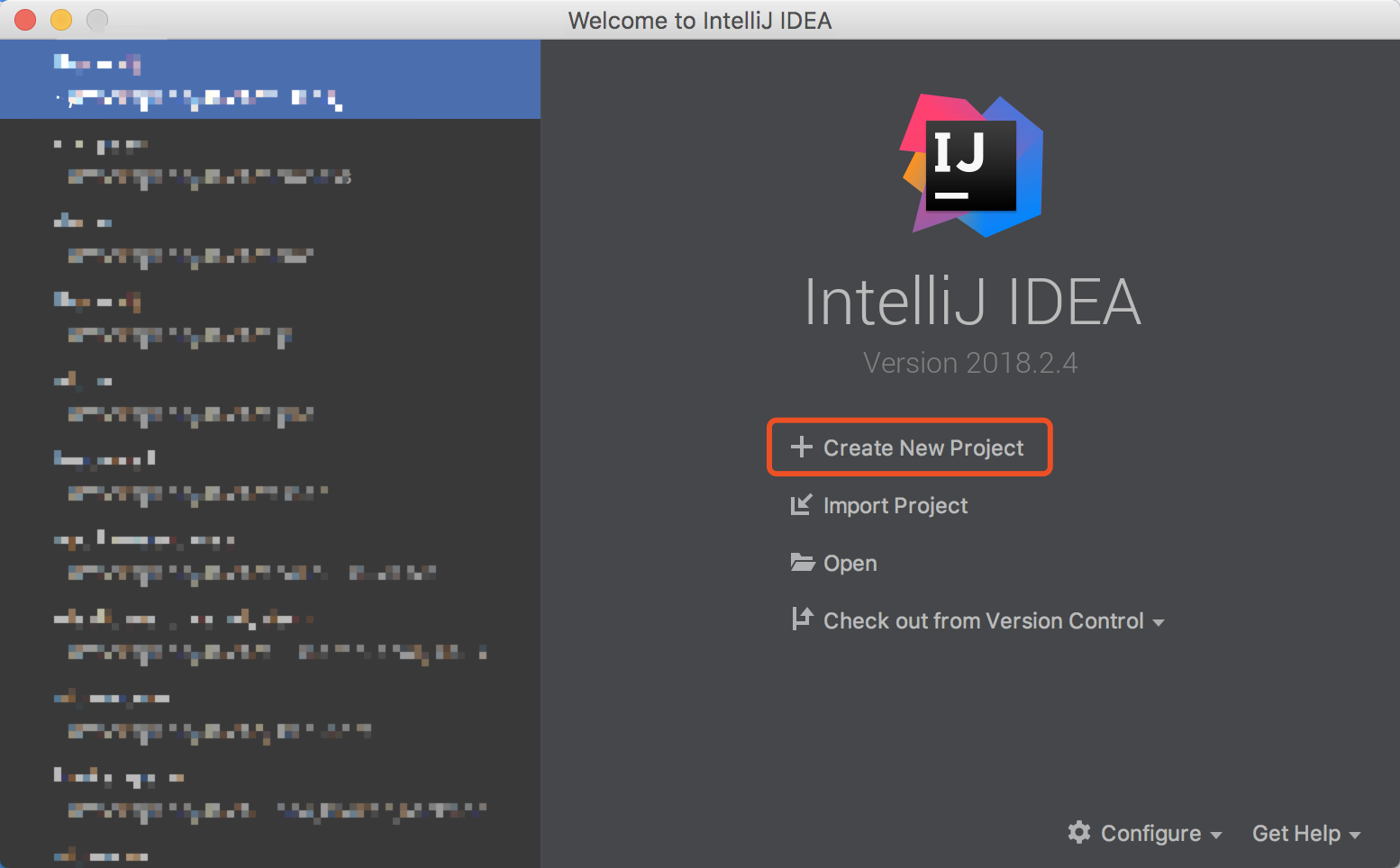
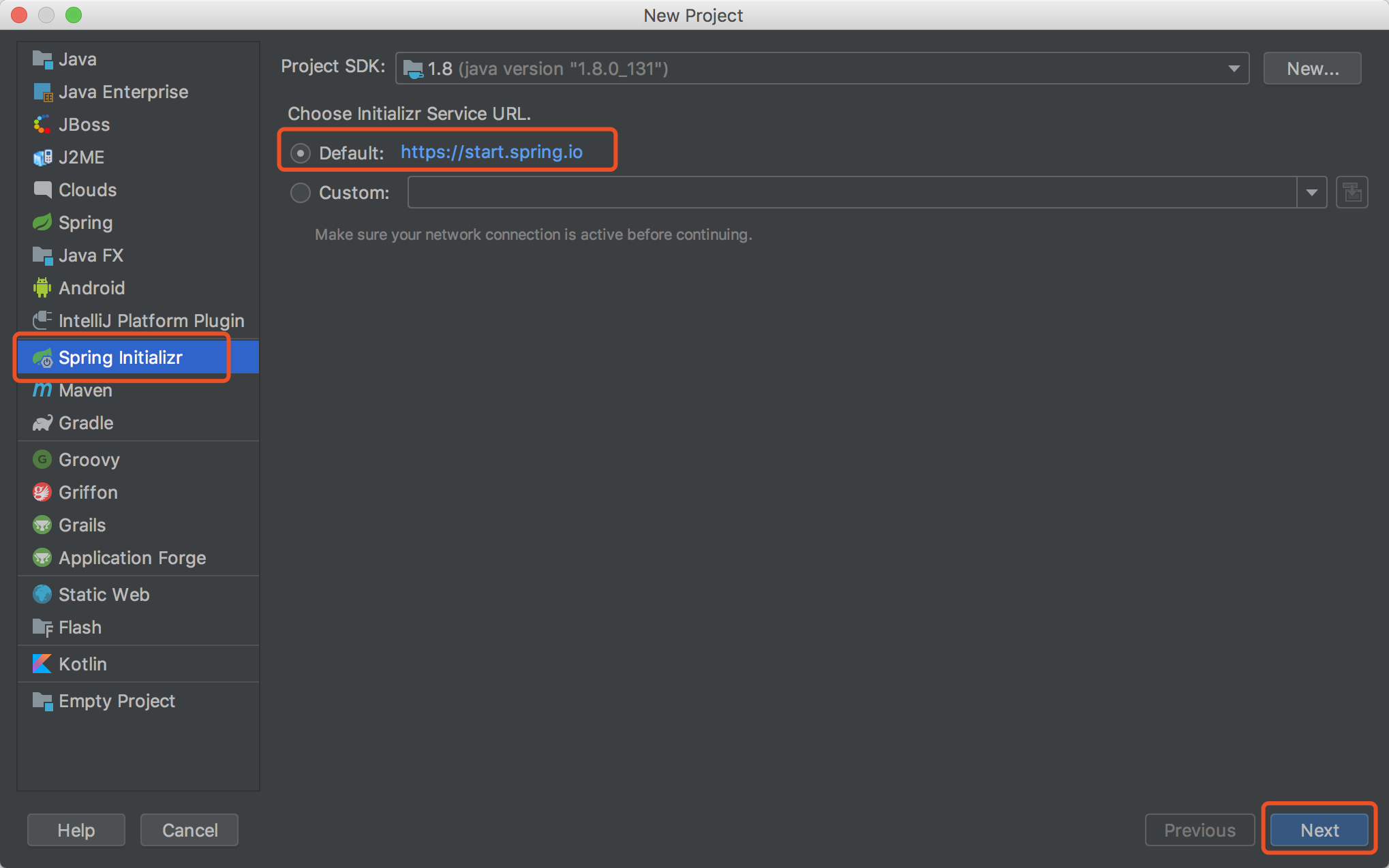


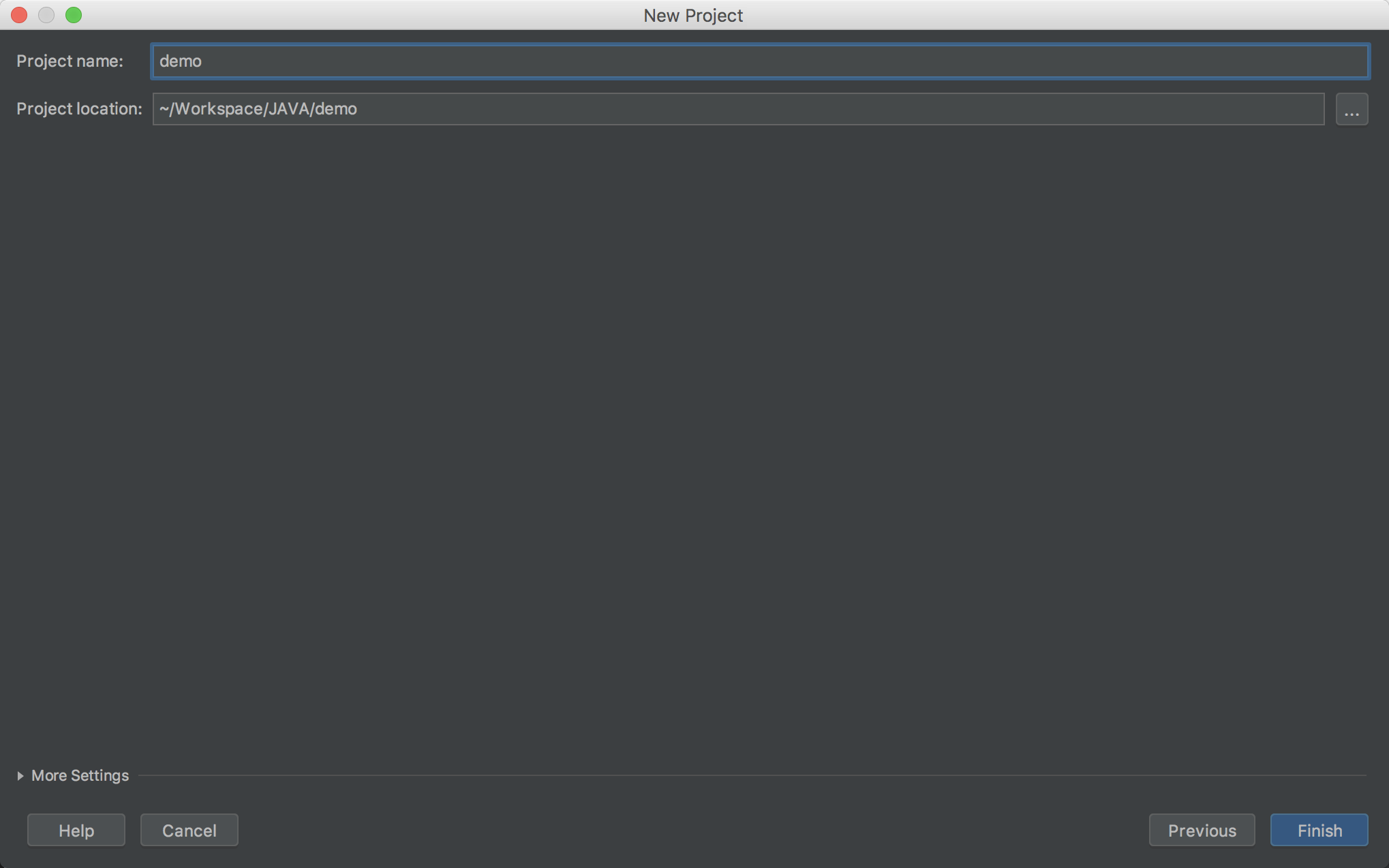
|-- demo
|-- .gitignore
|-- mvnw
|-- mvnw.cmd
|-- pom.xml
|-- .mvn
| |-- wrapper
| |-- maven-wrapper.jar
| |-- maven-wrapper.properties
|-- src
|-- main
| |-- java
| | |-- com
| | |-- example
| | |-- demo
| | |-- DemoApplication.java
| |-- resources
| |-- application.properties
|-- test
|-- java
|-- com
|-- example
|-- demo
|-- DemoApplicationTests.java⑦ 刪除無用的 .mvn 目錄、 src 目錄、 mvnw 及 mvnw.cmd 檔,最終只留 .gitignore 和 pom.xml
① 選擇專案根目錄,右鍵呼出功能表,選擇「 New -> Module 」


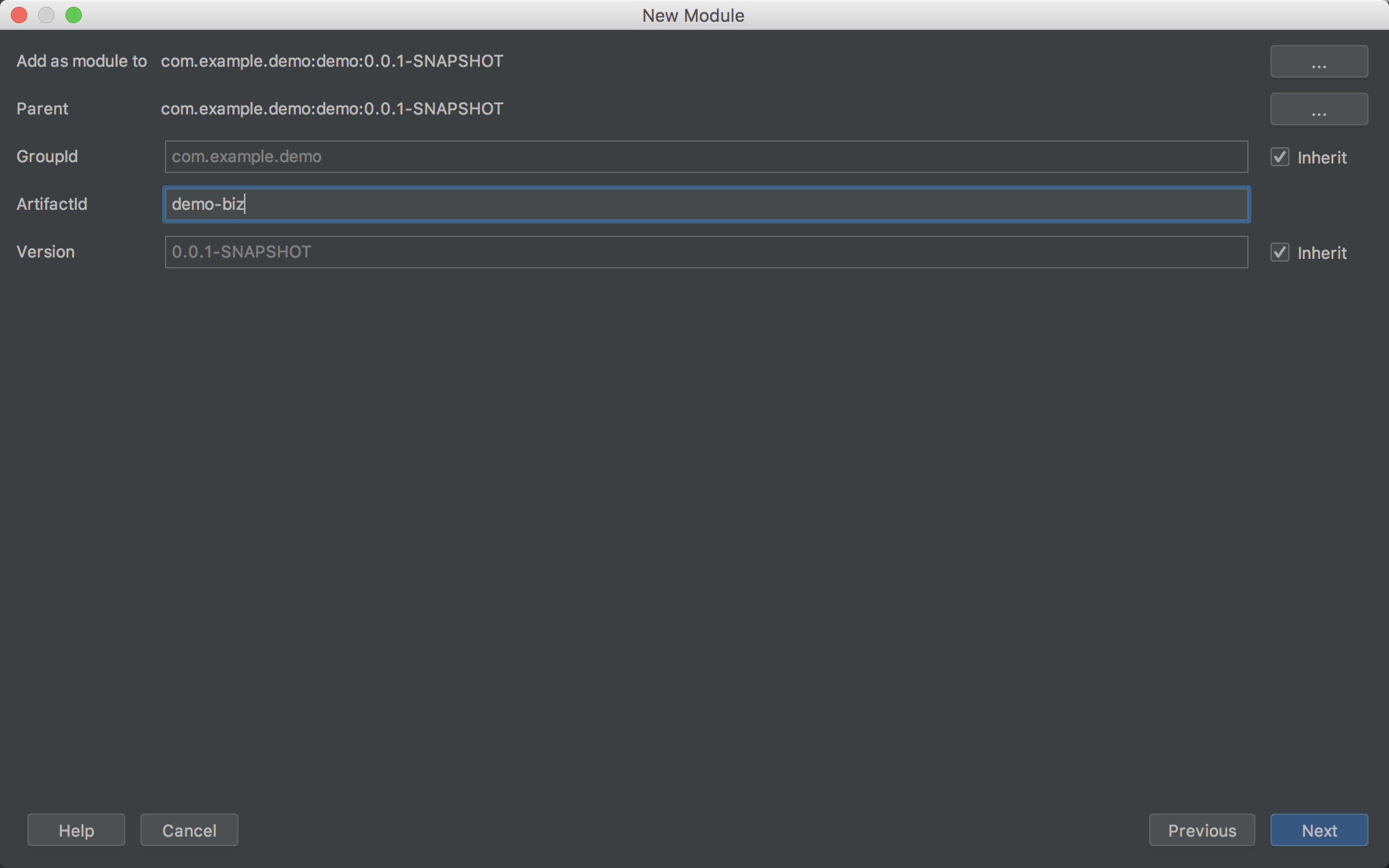
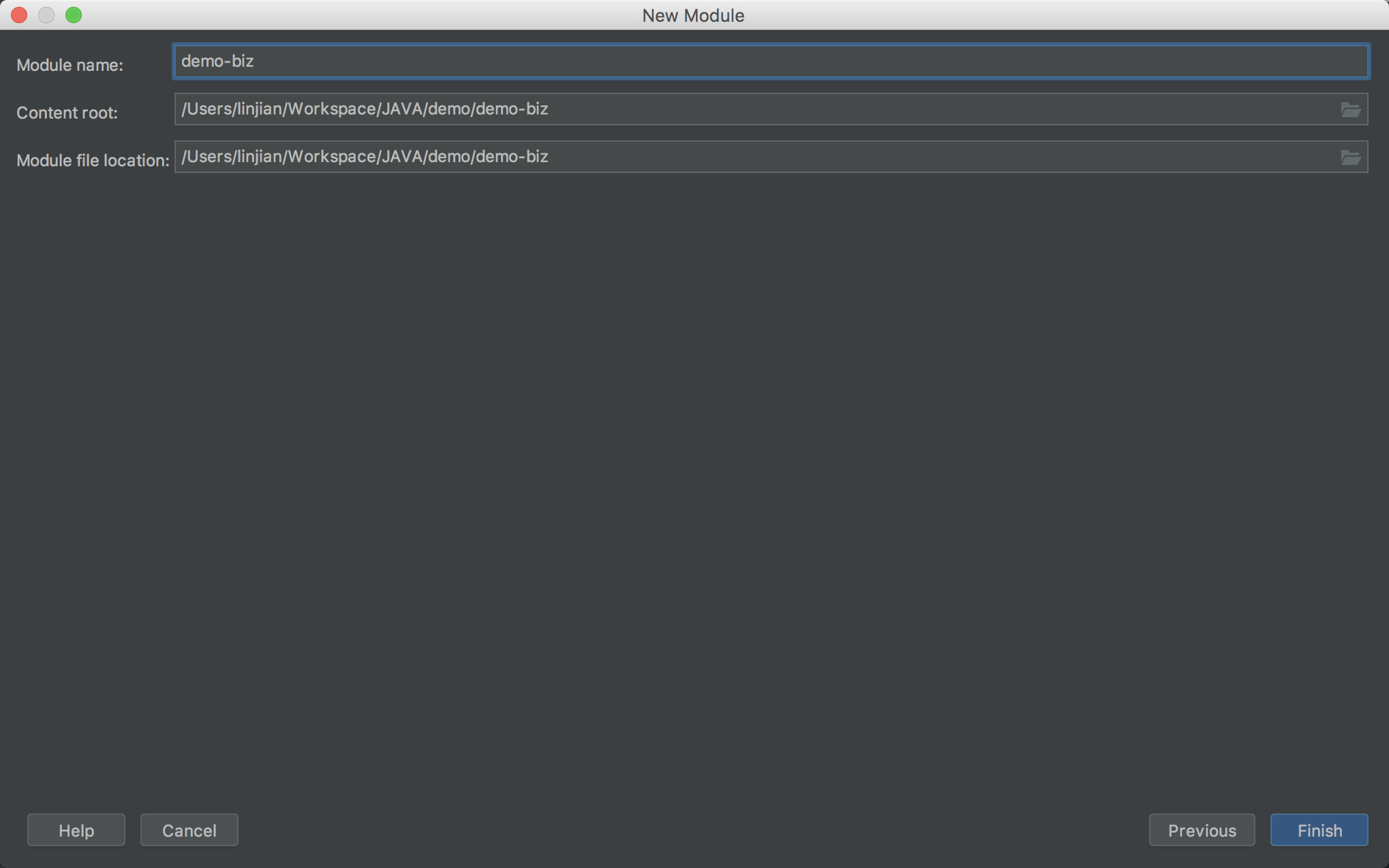
|-- demo
|-- .gitignore
|-- pom.xml
|-- demo-biz
| |-- pom.xml
| |-- src
| |-- main
| | |-- java
| | |-- resources
| |-- test
| |-- java
|-- demo-common
| |-- pom.xml
| |-- src
| |-- main
| | |-- java
| | |-- resources
| |-- test
| |-- java
|-- demo-dao
| |-- pom.xml
| |-- src
| |-- main
| | |-- java
| | |-- resources
| |-- test
| |-- java
|-- demo-web
|-- pom.xml
|-- src
|-- main
| |-- java
| |-- resources
|-- test
|-- java① 刪除 dependencies 標籤及其中的 spring-boot-starter 和 spring-boot-starter-test 依賴,因為 Spring Boot 提供的父工程已包含,並且父 pom 原則上都是通過 dependencyManagement 標籤管理依賴包。
注:dependencyManagement 及 dependencies 的區別自行查閱文檔
② 刪除 build 標籤及其中的所有內容,spring-boot-maven-plugin 外掛程式作用是打一個可運行的包,多模組專案僅僅需要在入口類所在的模組添加打包外掛程式,這裡父模組不需要打包運行。而且該外掛程式已被包含在 Spring Boot 提供的父工程中,這裡刪掉即可。 ③ 最後整理父 pom 檔中的其餘內容,按其代表含義歸類,整理結果如下:
<!-- 基本資訊 -->
<modelVersion>4.0.0</modelVersion>
<packaging>pom</packaging>
<name>demo</name>
<description>Demo project for Spring Boot</description>
<!-- 專案說明:這裡作為聚合工程的父工程 -->
<groupId>com.example.demo</groupId>
<artifactId>demo</artifactId>
<version>0.0.1-SNAPSHOT</version>
<!-- 繼承說明:這裡繼承Spring Boot提供的父工程 -->
<parent>
<groupId>org.springframework.boot</groupId>
<artifactId>spring-boot-starter-parent</artifactId>
<version>2.1.2.RELEASE</version>
<relativePath/>
</parent>
<!-- 模組說明:這裡聲明多個子模組 -->
<modules>
<module>demo-biz</module>
<module>demo-common</module>
<module>demo-dao</module>
<module>demo-web</module>
</modules>
<!-- 屬性說明 -->
<properties>
<java.version>1.8</java.version>
<demo.version>0.0.1-SNAPSHOT</demo.version>
</properties>準備工作都完成之後,通過一個簡易的 HTTP 介面測試專案是否正常運行。
① 首先在 demo-web 層創建 com.example.demo.web 包並添加入口類 DemoWebApplication.java
注:com.example.demo.web 為多級目錄結構並非單個目錄名
package com.example.demo.web;
import org.springframework.boot.SpringApplication;
import org.springframework.boot.autoconfigure.SpringBootApplication;
/**
* @author linjian
* @date 2019/1/15
*/
@SpringBootApplication
public class DemoWebApplication {
public static void main(String[] args) {
SpringApplication.run(DemoWebApplication.class, args);
}
}② 其次在 demo-web 層的 pom 檔中添加必要的依賴包
<dependencies>
<dependency>
<groupId>org.springframework.boot</groupId>
<artifactId>spring-boot-starter-web</artifactId>
</dependency>
</dependencies>② 然後在 com.example.demo.web 包中添加 controller 目錄並新建一個 controller,添加 test 方法測試介面是否可以正常訪問。
package com.example.demo.web.controller;
import org.springframework.web.bind.annotation.GetMapping;
import org.springframework.web.bind.annotation.RequestMapping;
import org.springframework.web.bind.annotation.RestController;
/**
* @author linjian
* @date 2019/1/15
*/
@RestController
@RequestMapping("demo")
public class DemoController {
@GetMapping("test")
public String test() {
return "Hello World!";
}
}③ 最後運行 DemoWebApplication 類中的 main 方法啟動專案,默認埠為 8080,訪問 http://localhost:8080/demo/test 即可測試介面
通常 JAVA Web 專案會按照功能劃分不同模組,模組之間通過依賴關係進行協作,下面將完善模組之間的依賴關係。
① 首先在父 pom 檔中使用「 dependencyManagement 」標籤聲明所有子模組依賴
<!-- 依賴管理:這裡統一管理依賴的版本號 -->
<dependencyManagement>
<dependencies>
<dependency>
<groupId>com.example.demo</groupId>
<artifactId>demo-biz</artifactId>
<version>${demo.version}</version>
</dependency>
<dependency>
<groupId>com.example.demo</groupId>
<artifactId>demo-common</artifactId>
<version>${demo.version}</version>
</dependency>
<dependency>
<groupId>com.example.demo</groupId>
<artifactId>demo-dao</artifactId>
<version>${demo.version}</version>
</dependency>
<dependency>
<groupId>com.example.demo</groupId>
<artifactId>demo-web</artifactId>
<version>${demo.version}</version>
</dependency>
</dependencies>
</dependencyManagement>注:${demo.version} 定義在 properties 標籤中
② 其次在 demo-biz 層中的 pom 檔中添加 demo-dao 及 demo-common 依賴
<dependencies>
<dependency>
<groupId>com.example.demo</groupId>
<artifactId>demo-common</artifactId>
</dependency>
<dependency>
<groupId>com.example.demo</groupId>
<artifactId>demo-dao</artifactId>
</dependency>
</dependencies>③ 之後在 demo-web 層中的 pom 檔中添加 demo-biz 依賴
<dependencies>
<dependency>
<groupId>com.example.demo</groupId>
<artifactId>demo-biz</artifactId>
</dependency>
</dependencies>模組依賴關係配置完成之後,通過 web 層 測試下 biz 層的介面是否可以正常調用。
① 首先在 demo-biz 層創建 com.example.demo.biz 包,添加 service 目錄並在其中創建 DemoService 介面類別及 impl 目錄(用於存放介面實現類)。
package com.example.demo.biz.service;
/**
* @author linjian
* @date 2019/1/15
*/
public interface DemoService {
String test();
}package com.example.demo.biz.service.impl;
import com.example.demo.biz.service.DemoService;
import org.springframework.stereotype.Service;
/**
* @author linjian
* @date 2019/1/15
*/
@Service
public class DemoServiceImpl implements DemoService {
@Override
public String test() {
return "interface test";
}
}② DemoController 通過 @Autowired 注解注入 DemoService ,修改 DemoController 的 test 方法使之調用 DemoService 的 test 方法
@Autowired
private DemoService demoService;
@GetMapping("test")
public String test() {
return demoService.test();
}③ 再次運行 DemoWebApplication 類中的 main 方法啟動專案,發現如下報錯
***************************
APPLICATION FAILED TO START
***************************
Description:
Field demoService in com.example.demo.web.controller.DemoController required a bean of type 'com.example.demo.biz.service.DemoService' that could not be found.
The injection point has the following annotations: - @org.springframework.beans.factory.annotation.Autowired(required=true)
Action:
Consider defining a bean of type 'com.example.demo.biz.service.DemoService' in your configuration.原因是找不到 DemoService 類
④ 在 DemoWebApplication 入口類中增加包掃描,設置 @SpringBootApplication 注解中的 scanBasePackages 值為 com.example.demo
@SpringBootApplication(scanBasePackages = "com.example.demo")⑤ 設置完後重新運行 main 方法,專案正常啟動,訪問 http://localhost:8080/demo/test 測試介面
以上介面均是靜態的,不涉及資料庫操作,下面將集成 MyBatis 訪問資料庫中的資料。
① 首先父 pom 檔中聲明 mybatis-spring-boot-starter 及 lombok 依賴
<dependency>
<groupId>org.mybatis.spring.boot</groupId>
<artifactId>mybatis-spring-boot-starter</artifactId>
<version>1.3.2</version>
</dependency>
<dependency>
<groupId>org.projectlombok</groupId>
<artifactId>lombok</artifactId>
<version>1.16.22</version>
</dependency>② 其次在 demo-dao 層中的 pom 檔中添加上述依賴
<dependencies>
<dependency>
<groupId>mysql</groupId>
<artifactId>mysql-connector-java</artifactId>
</dependency>
<dependency>
<groupId>org.mybatis.spring.boot</groupId>
<artifactId>mybatis-spring-boot-starter</artifactId>
</dependency>
<dependency>
<groupId>org.projectlombok</groupId>
<artifactId>lombok</artifactId>
</dependency>
</dependencies>③ 之後在 demo-dao 層創建 com.example.demo.dao 包,通過 mybatis-genertaor 工具生成 dao 層相關檔( DO 、 Mapper 、 xml ),目錄結構如下
|-- demo-dao
|-- pom.xml
|-- src
|-- main
| |-- java
| | |-- com
| | |-- example
| | |-- demo
| | |-- dao
| | |-- entity
| | | |-- UserDO.java
| | |-- mapper
| | |-- UserMapper.java
| |-- resources
| |-- mybatis
| |-- UserMapper.xml
|-- test
|-- java④ 然後在 demo-web 層中的 resources 目錄 創建 applicatio.properties 檔並在其中添加 datasource 及 MyBatis 相關配置項
spring.datasource.driverClassName = com.mysql.jdbc.Driver
spring.datasource.url = jdbc:mysql://localhost:3306/test?useUnicode=true&characterEncoding=utf-8
spring.datasource.username = test
spring.datasource.password = 123456
mybatis.mapper-locations = classpath:mybatis/*.xml
mybatis.type-aliases-package = com.example.demo.dao.entity注:如果生成的 xml 在 dao 層 resources 目錄的子目錄中則 mybatis.mapper-locations 需設置為 classpath:mybatis/*/*.xml
⑤ DemoService 通過 @Autowired 注解注入 UserMapper ,修改 DemoService 的 test 方法使之調用 UserMapper 的 selectById 方法
@Autowired
private UserMapper userMapper;
@Override
public String test() {
UserDO user = userMapper.selectById(1);
return user.toString();
}⑥ 再次運行 DemoWebApplication 類中的 main 方法啟動項目,出現如下報錯
***************************
APPLICATION FAILED TO START
***************************
Description:
Field userMapper in com.example.demo.biz.service.impl.DemoServiceImpl required a bean of type 'com.example.demo.dao.mapper.business.UserMapper' that could not be found.
The injection point has the following annotations: - @org.springframework.beans.factory.annotation.Autowired(required=true)
Action:
Consider defining a bean of type 'com.example.demo.dao.mapper.business.UserMapper' in your configuration.原因是找不到 UserMapper 類
⑦ 在 DemoWebApplication入口類中增加 dao 層包掃描,添加 @MapperScan 注解並設置其值為 com.example.demo.dao.mapper
@MapperScan("com.example.demo.dao.mapper")⑧ 設置完後重新運行 main 方法,專案正常啟動,訪問 http://localhost:8080/demo/test 測試介面
外部 Tomcat 部署的話,就不能依賴於入口類的 main 函數了,而是要以類似於 web.xml 檔配置的方式來啟動 Spring應用上下文。 ① 在入口類中繼承 SpringBootServletInitializer 並實現 configure 方法
public class DemoWebApplication extends SpringBootServletInitializer {
@Override
protected SpringApplicationBuilder configure(SpringApplicationBuilder builder) {
return builder.sources(DemoWebApplication.class);
}
public static void main(String[] args) {
SpringApplication.run(DemoWebApplication.class, args);
}
}② 之前在 demo-web 引入了 spring-boot-starter-web 的依賴,該依賴包包含內嵌的 Tomcat 容器,所以直接部署在外部 Tomcat 會衝突報錯。這裡在 demo-web 層中的 pom 文件中重定義 spring-boot-starter-tomcat 依賴包的「 scope 」即可解決該問題。
<dependency>
<groupId>org.springframework.boot</groupId>
<artifactId>spring-boot-starter-tomcat</artifactId>
<scope>provided</scope>
</dependency>③ 聲明 demo-web 層的打包方式及最終的包名
<packaging>war</packaging>
...省略其餘部分...
<build>
<finalName>demo</finalName>
</build>④ 此時在 demo-web 層目錄執行「 mvn clean install 」即可打出一個名為 demo.war 的包。
在日常開發中,通常不止一套環境,如開發環境、測試環境、預發環境、生成環境,而每個環境的配置項可能都不一樣,這就需要用到多環境打包來解決這個問題。
① 在 demo-web 層的 resources 目錄中新建 conf 目錄,再在其中按照環境創建相應目錄,這裡創建開發環境「 dev 」及測試環境「 test 」,再將原本的 application.properties 檔分別拷貝一份到兩個目錄中,根據環境修改其中的配置項,最後刪除原本的設定檔。得到目錄結構如下:
|-- resources
|-- conf
|-- dev
| |-- application.properties
|-- test
|-- application.properties② 往 demo-web 層的 pom 文件添加 profile 標籤
<profiles>
<profile>
<id>dev</id>
<properties>
<profile.env>dev</profile.env>
</properties>
<activation>
<activeByDefault>true</activeByDefault>
</activation>
</profile>
<profile>
<id>test</id>
<properties>
<profile.env>test</profile.env>
</properties>
</profile>
</profiles>注:其中 dev 為默認啟動的 profile ,如要增加其他環境按照上述步驟操作即可。
③ 設置打包時資源檔路徑
<build>
<finalName>demo</finalName>
<resources>
<resource>
<directory>${basedir}/src/main/resources</directory>
<excludes>
<exclude>conf/**</exclude>
</excludes>
</resource>
<resource>
<directory>src/main/resources/conf/${profile.env}</directory>
</resource>
</resources>
</build>注:${basedir} 為當前子模組的根目錄
④ 打包時通過「 P 」參數指定 profile
mvn clean install -P testarchetype 是一個 Maven 專案範本工具包,通過 archetype 我們可以快速搭建 Maven 項目。

① cd 到專案根目錄(即父 pom 檔所在目錄)執行 mvn 命令,此時會在專案根目錄生成 target 目錄,其包含一個名為 generated-sources 的目錄
mvn archetype:create-from-project② 打開「 /target/generated-sources/archetype/src/main/resources/META-INF/maven/ 」目錄下的 archetype-metadata.xml 檔,從中清理一些不需要的檔,如 IDEA 的一些文件(.idea、.iml)等。
<fileSet filtered="true" encoding="UTF-8">
<directory>.idea/libraries</directory>
<includes>
<include>**/*.xml</include>
</includes>
</fileSet>
<fileSet filtered="true" encoding="UTF-8">
<directory>.idea/inspectionProfiles</directory>
<includes>
<include>**/*.xml</include>
</includes>
</fileSet>
<fileSet filtered="true" encoding="UTF-8">
<directory>.idea/artifacts</directory>
<includes>
<include>**/*.xml</include>
</includes>
</fileSet>
<fileSet filtered="true" encoding="UTF-8">
<directory>.idea</directory>
<includes>
<include>**/*.xml</include>
</includes>
</fileSet>③ 然後 cd target/generated-sources/archetype/,然後執行 install 命令,在本地倉庫的根目錄生成 archetype-catalog.xml 骨架設定檔
mvn install檔內容如下:
<?xml version="1.0" encoding="UTF-8"?>
<archetype-catalog xsi:schemaLocation="http://maven.apache.org/plugins/maven-archetype-plugin/archetype-catalog/1.0.0 http://maven.apache.org/xsd/archetype-catalog-1.0.0.xsd"
xmlns="http://maven.apache.org/plugins/maven-archetype-plugin/archetype-catalog/1.0.0"
xmlns:xsi="http://www.w3.org/2001/XMLSchema-instance">
<archetypes>
<archetype>
<groupId>com.example.demo</groupId>
<artifactId>demo-archetype</artifactId>
<version>0.0.1-SNAPSHOT</version>
<description>demo</description>
</archetype>
</archetypes>
</archetype-catalog>到本機的工作目錄執行 mvn archetype:generate -DarchetypeCatalog=local 從本地 archeType 範本中創建專案
~/Workspace/JAVA $ mvn archetype:generate -DarchetypeCatalog=local
[INFO] Scanning for projects...
[INFO]
[INFO] Using the builder org.apache.maven.lifecycle.internal.builder.singlethreaded.SingleThreadedBuilder with a thread count of 1
[INFO]
[INFO] ------------------------------------------------------------------------
[INFO] Building Maven Stub Project (No POM) 1
[INFO] ------------------------------------------------------------------------
[INFO]
[INFO] >>> maven-archetype-plugin:3.0.1:generate (default-cli) @ standalone-pom >>>
[INFO]
[INFO] <<< maven-archetype-plugin:3.0.1:generate (default-cli) @ standalone-pom <<<
[INFO]
[INFO] --- maven-archetype-plugin:3.0.1:generate (default-cli) @ standalone-pom ---
[INFO] Generating project in Interactive mode
[INFO] No archetype defined. Using maven-archetype-quickstart (org.apache.maven.archetypes:maven-archetype-quickstart:1.0)
Choose archetype:
1: local -> com.example.demo:demo-archetype (demo)
Choose a number or apply filter (format: [groupId:]artifactId, case sensitive contains): : 1
Define value for property 'groupId': com.orz.test
Define value for property 'artifactId': test
Define value for property 'version' 1.0-SNAPSHOT: :
Define value for property 'package' com.orz.test: :
Confirm properties configuration:
groupId: com.orz.test
artifactId: test
version: 1.0-SNAPSHOT
package: com.orz.test
Y: : y
[INFO] ----------------------------------------------------------------------------
[INFO] Using following parameters for creating project from Archetype: demo-archetype:0.0.1-SNAPSHOT
[INFO] ----------------------------------------------------------------------------
[INFO] Parameter: groupId, Value: com.orz.test
[INFO] Parameter: artifactId, Value: test
[INFO] Parameter: version, Value: 1.0-SNAPSHOT
[INFO] Parameter: package, Value: com.orz.test
[INFO] Parameter: packageInPathFormat, Value: com/orz/test
[INFO] Parameter: package, Value: com.orz.test
[INFO] Parameter: version, Value: 1.0-SNAPSHOT
[INFO] Parameter: groupId, Value: com.orz.test
[INFO] Parameter: artifactId, Value: test
[INFO] Parent element not overwritten in /Users/linjian/Workspace/JAVA/test/test-biz/pom.xml
[INFO] Parent element not overwritten in /Users/linjian/Workspace/JAVA/test/test-common/pom.xml
[INFO] Parent element not overwritten in /Users/linjian/Workspace/JAVA/test/test-dao/pom.xml
[INFO] Parent element not overwritten in /Users/linjian/Workspace/JAVA/test/test-web/pom.xml
[INFO] Project created from Archetype in dir: /Users/linjian/Workspace/JAVA/test
[INFO] ------------------------------------------------------------------------
[INFO] BUILD SUCCESS
[INFO] ------------------------------------------------------------------------
[INFO] Total time: 01:01 min
[INFO] Finished at: 2019-01-15T18:51:31+08:00
[INFO] Final Memory: 14M/155M
[INFO] ------------------------------------------------------------------------上面羅列出了所有可用的範本,首先選擇使用哪個範本,這裡選擇 1 ,其次輸入「 groupId 」、「 articleId 」、「 version 」及「 package 」,然後輸入「 Y 」確認創建,最終專案創建成功。
至此 Spring Boot Maven 多模組專案的搭建過程已經介紹完畢,後續會在此基礎上繼續集成一些中介軟體。



